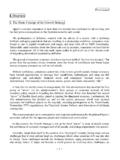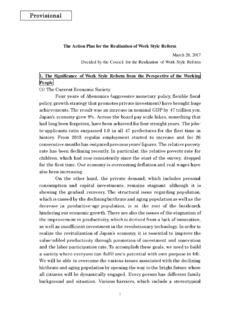Transcription of Japan Revitalization Strategy - Kantei
1 Provisional Japan Revitalization Strategy - Japan is BACK- June 14, 2013. Provisional Table of Contents I. Overview 1. The Basic concept of the growth Strategy .. 1. 2. Roadmap to growth .. 3. (1) Unleashing the power of the private sector to the fullest extent (2) Participation by all & fostering human resources who can succeed in the global competition (3) Creating new frontiers (4) Redistributing the fruits of growth to peoples' lives 3. How to Realize the growth Strategy .. 10. (1) Implementing policies at unprecedented speed (2) Accelerating reforms with National Strategic Special Zones serving as the gateway 4. An Evolving growth Strategy .. 11. (1) Implementing the PDCA cycle by reviewing targets (KPIs). (2) Way forward for realizing full-fledged growth 5. Examples of Necessary Key Measures in Line with the Roadmap to growth .. 14. (1) Unleashing the power of the private sector to the fullest extent (2) Participation by all & fostering human resources who can succeed in the global competition (3) Creating new frontiers II.
2 Three Action Plans 1. Industry Revitalization Plan .. 30. 1. Accelerating structural reform program (Vitalizing industries) .. 31. (1) Stimulating private investment (2) Establishing a system which enables challenges to frontiers being free from anxiety (3) Promoting investment in business ventures and investment to challenge businesses again fully utilizing resources in and outside Japan (4) Promoting business restructuring and reorganization (5) Promoting overseas operations aiming to become a global leading company 2. Reforming the employment system and reinforcing human resources capabilities .. 39. (1) Policy change from excessive employment stability to labor fluidity (realizing labor movement without unemployment). (2) Enhancing matching function by utilizing the private-sector human resources business (3) Realizing various ways of working (4) Promoting active participation by women (5) Promoting active participation by the young/the elderly Provisional (6) University reforms (7) Strengthening human resources capabilities for global operation activities (8) Utilizing highly skilled overseas personnel 3.
3 Promoting Science, Technology and Innovation .. 54. (1) Reinforcing headquater functions of the Council for Science and Technology Policy . (2) Promoting the Strategic Innovation Program (3) Establishing Innovative R&D Program (4) Enhancing function of national research institutes (5) Securing funds for personnel who supports research (6) Increasing R&D investment by the public and private sectors (7) Strengthening intellectual property strategies/standardization strategies 4. Becoming the world's leading IT society .. 60. (1) Reforming regulations/systems suitable for the age that the existence of IT is natural . (2) Promoting private sector access to public data and developing innovative electronic administrative services (3) Realizing safe/convenient life environment through IT utilization (4) Developing the world's top-level telecommunication infrastructure (5) Promoting cyber security measures (6) Cultivating/securing highly-skilled IT human resources that will be the source of industrial competitiveness 5.
4 Further strengthening Japan 's international competitiveness as a business hub .. 65. (1) Realizing National Strategic Special Zones . (2) Opening up operation right of public facilities, etc., to the private sector (expanding utilization of PPP/PFI). (3) Improving infrastructure such as airports, ports and harbors (4) Improving competitiveness of cities (5) Vitalizing financial/capital markets (6) Management of public and quasi-public funds (7) Overcoming constraints of environment/energy 6. Innovation of small and medium-sized enterprises (SMEs) .. 74. (1) Using, mobilizing, and commercializing regional resources as brands (2) Accelerating the restructuring of small and medium-sized enterprise (SMEs). (3) Supporting small and medium-sized enterprises (SMEs) which will enter the strategic market. (4) Supporting small and medium-sized enterprises (SMEs) which expand internationally <Important notices>. 2. Strategic Market Creation Plan .. 81. Provisional Theme 1: Extending the nation's healthy life expectancy.
5 83. [1] The society where people are able to live a healthy life and get old by enhancing effective preventive care services and health management. [2] The society which can provide the world's most advanced necessary medical care by activating medicine-related industries [3] The society where people who are out of work due to illness or injury can return to work as quickly as possible by access to better medical care and nursing care Theme 2: Realizing clean and economical energy demand and supply .. 99. [1] A society where clean and economical energy is supplied [2] A society where efficient distribution of energy is realized through competition [3] A society where energy is consumed wisely Theme 3: Building safe, convenient and economical next-generation infrastructures .. 109. [1] A society where safe and resilient infrastructures are provided at low cost [2] A society where people and goods are provided with safe and convenient transportation Theme 4: Building regional communities that use their unique local resources to appeal to the world.
6 115. [1] A rich rural society which produces rich world's best quality agricultural, forestry and fishery products and food produce [2] A society which makes use of potential such as tourism resources to invite many world's tourists to regional communities 3. Strategy of Global 127. 1. Building strategic trading relations and promoting economic partnership .. 128. 2. Strategic initiatives for obtaining overseas markets .. 130. (1) Exporting infrastructure and securing natural resources (2) Intensive support to potential small and medium-sized enterprises (SMEs). (3) Promoting Cool Japan 3. Improving infrastructure concerning funds and human resources to support our economic growth .. 137. (1) Activating inward direct investment (2) Developing globally competitive human resources [reposted]. Provisional I. Overview 1. The Basic concept of the growth Strategy Japan 's economic stagnation of more than two decades has continued for far too long, and has had grave consequences on the Japanese economy and society.
7 The prolongation of deflation, coupled with the advent of a society with a declining birthrate and aging population that are resulting in a decreasing workforce, companies were forced to rein in capital investments and wages, and even hold off on R&D investments. Meanwhile, amid concerns about the future and cuts in incomes, consumers too have had to reduce consumption. All of this has made Japan unable to pull itself out of the vicious cycle of stagnating demand and accelerating deflation. This period of long-term economic slowdown has been dubbed the lost two decades. Far graver than the economic losses, however, were the losses of confidence and future hopes among company managers as well as individuals. Without confidence, companies cannot take risks in new growth sectors; human resources have limited opportunities to leverage their capabilities; technologies and ideas are left neglected; and individuals' financial assets and companies' internal reserves are underutilized.
8 This naturally leaves human talents, goods, and funds structurally idle.. In less than six months since its inauguration, the Abe administration has launched the first prong or arrow (of the administration's three prongs of economic revival) of bold monetary policy aimed at dispelling the deflation mindset. It has also launched the second arrow of flexible fiscal policy aimed at igniting the dampened economy. Furthermore, the Abe administration has decided on, and set into action, processes which were deemed necessary but had been placed on the wayside, including participation in the Trans-Pacific Partnership (TPP) negotiations, the Electricity System Reform, and elimination of childcare waiting lists. The consequent pick-up in consumption and corporate performance has brightened Japan 's economic outlook for the Japanese people and international communities. In this context, the growth Strategy 's role as the third arrow is clear. It should restore the confidence of company managers and of all people, and change expectations into actions.
9 Currently, Japan finds itself in the position of a developed country, facing many -1- Provisional serious challenges that it must address head on, challenges which other countries will one day also be facing. These challenges include the declining birthrate, aging population, and resource and energy issues. If Japan can become a world pioneer in resolving these challenges, an opportunity presents itself for Japan to become a global leader in new growth sectors. Japan will once again implement aggressive economic policies that inspire motivation to tackle difficult challenges ( challenge ), carve out new growth sectors ( innovation ), both domestically and internationally ( open ), and mobilize, in one stroke, human talents, goods, and funds which had fallen idle ( action ). If, as the stagnant economy starts to move again, Japan is able to promote replacement of old facilities and equipment with new ones, as well as to accelerate both investment in growth sectors and in labor mobility, then corporate earnings will increase, which will deliver returns for the people in the form of higher worker salaries and increased employment.
10 This will lead to the realization of a virtuous cycle, where consumption will increase, triggering new investment, creating spillovers for communities and small and medium-sized enterprises (SMEs). This growth Strategy will mark a fresh start. By having all economic actors in the private sector actively and dynamically undertake full-fledged efforts to promote growth with a determination to take on challenges, a virtuous cycle will be set into motion for the first time, elevating the Japanese economy from stagnation to revival and to even greater heights, and in turn, enabling the economy to be placed on a growth trajectory. Through the implementation of the three arrows, including this growth Strategy , among other measures, Japan aims to achieve a vibrant economy that will register over 2% labor productivity improvement in the medium- to long-term, and around 3%. nominal gross domestic product (GDP) growth and around 2% real GDP growth , on average, over the next ten years.









